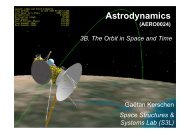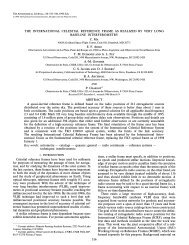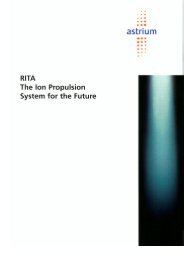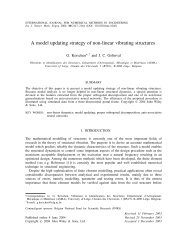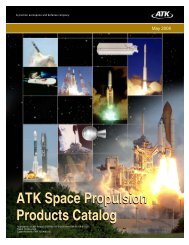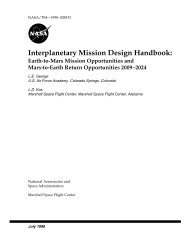CASSINI MANEUVER EXPERIENCE: FINISHING INNER CRUISE
CASSINI MANEUVER EXPERIENCE: FINISHING INNER CRUISE
CASSINI MANEUVER EXPERIENCE: FINISHING INNER CRUISE
You also want an ePaper? Increase the reach of your titles
YUMPU automatically turns print PDFs into web optimized ePapers that Google loves.
The total AV is useful for discussing the whole execution error<br />
while the burn & turns AV is useful in comparing with the<br />
AACS results. See Figure 4.<br />
Errors in all of these events contribute to the total<br />
maneuver execution error. Execution performance is<br />
primarily dependent upon performance of the on-board<br />
accelerometer and the attitude control system performance.<br />
The latter is very dependent upon pre-aiming the main engine.<br />
If the pre-aim is incorrect, the main engine is pointed such that<br />
its thrust produces a torque upon the spacecraft. The attitude<br />
control system works to remove this torque and to orient the<br />
spacecraft so that the main engine thrust vector matches the<br />
desired burn direction.<br />
Total<br />
AV<br />
Burn &<br />
AV<br />
roll wind turn<br />
yaw wind turn<br />
yaw unwind turn<br />
pointing bias fix (wind turn)<br />
pointing bias fix (unwind turn)<br />
"""""""".<br />
"""""""".<br />
deadband tightening<br />
post-maneuver firing<br />
. """"~"""""""<br />
Figure 4: Definitions<br />
' AV<br />
Turns<br />
Execution errors are modeled using the Gates model.[8]<br />
The Gates model accounts for four independent error sources,<br />
two each for magnitude errors and pointing errors. These are<br />
either fixed errors or proportional. Each parameter represents<br />
the standard deviation for that error source and each error<br />
source is assumed to have zero mean.<br />
Maneuvers are forecast and, once executed, judged<br />
according to the levied execution error requirements. The pre-<br />
launch requirements are listed in Table 11.<br />
One may compute execution errors by simply<br />
subtracting the expected from the actual AV, but most of the<br />
insight into the source of the error comes after judiciously<br />
choosing a coordinate system to represent it with. Each<br />
maneuver AV is in a different inertial direction, but is<br />
controlled by spacecraft on-board systems, the accelerometer<br />
and attitude control system. It makes sense, then, to use a<br />
body-fixed coordinate system instead of an inertial system<br />
when analyzing the errors. A coordinate system definition,<br />
referred to as spacecraft coordinates X, Y, and Z,,, already<br />
exists for Cassini and is denoted in Figure 3. The Z, axis<br />
points from the high-gain antenna to the main engine, the Y,<br />
axis points away from the probe, and the X, axis completes<br />
the right-handed system.<br />
4<br />
Table 11: TCM Error Requirements (3-0)<br />
However, a coordinate system with an axis parallel to the<br />
expected AV is preferred. The compromise is a coordinate<br />
system with Z parallel to the expected AV, X parallel to the<br />
projection of X,,, into the plane perpendicular to Z, and Y<br />
completes the right-handed system. The plane perpendicular<br />
to Z is referred to herein as the pointing plane.<br />
<strong>MANEUVER</strong> <strong>EXPERIENCE</strong><br />
After TCM-2, two flight software corrections were<br />
made, both relating to the accelerometer. The accelerometer<br />
scale factor was in error by 1%, biasing the ,system to<br />
overburn by that amount. The other correction was one made<br />
to the algorithm which compensates for the misalignment<br />
between the accelerometer mounting and the thrust vector.<br />
This potentially reduced burn magnitude error by as much as<br />
0.8%. These two corrections are credited with the excellent<br />
magnitude errors discussed below.<br />
DSM<br />
The Deep Space Maneuver (DSM) was the largest that<br />
this spacecraft will execute prior to the Saturn Orbit Insertion<br />
(SOI) in 2004. The DSM was also the only maneuver for<br />
which the propulsion system was fully pressure-regulated and<br />
no other maneuver will be fully pressure-regulated until the<br />
s 01.<br />
'Given in mm/s<br />
+Uncalibrated (TCM-1, TCM-2, and SOI)<br />
Calibrated<br />
' For long burns, such as the DSM and SOI, this requirement<br />
is relaxed to 30mrad. However, high quality gyros were<br />
procured and the star sensor remains in use during the burn,<br />
making the relaxation unnecessary.



